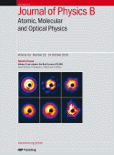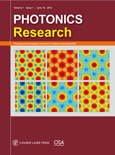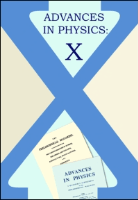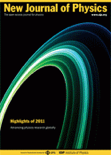
JOURNAL OF PHYSICS B-ATOMIC MOLECULAR AND OPTICAL PHYSICS
Scope & Guideline
Pioneering Discoveries in the Realm of Atoms and Molecules
Introduction
Aims and Scopes
- Atomic and Molecular Physics:
Research in this area encompasses studies of atomic structure, ionization processes, and molecular interactions, often focusing on the behavior of electrons in various atomic and molecular systems. - Quantum Dynamics and Control:
This scope includes investigations into the manipulation of quantum states and the dynamics of quantum systems, particularly in the context of coherent control and quantum information processing. - Laser-Matter Interactions:
Papers often explore the interactions between intense laser fields and matter, including phenomena like high-order harmonic generation, laser-induced ionization, and ultrafast spectroscopy. - Quantum Optics and Photonics:
This area covers the study of light-matter interactions at the quantum level, including entanglement, quantum coherence, and the generation of nonclassical states of light. - Statistical and Computational Methods:
The journal publishes work utilizing computational methods and statistical mechanics to analyze complex atomic and molecular systems, enhancing our understanding of various physical phenomena. - New Experimental Techniques:
Research that develops or applies novel experimental techniques in atomic, molecular, and optical physics, such as advanced spectroscopy, imaging methods, and trap technologies.
Trending and Emerging
- Attosecond Physics:
Research on attosecond science, particularly in attosecond pulse generation and its applications, is gaining traction, reflecting the growing interest in ultrafast phenomena. - Quantum Information and Computing:
The exploration of quantum information science, including quantum key distribution and quantum algorithms, is emerging as a significant theme, highlighting the intersection of physics with computer science. - Nonlinear and Strong-Field Physics:
There is an increasing emphasis on nonlinear optics and strong-field physics, particularly involving high-order harmonic generation and laser-matter interactions under extreme conditions. - Quantum Simulation and Many-Body Physics:
Research focusing on quantum simulation techniques and the study of many-body quantum systems is trending, driven by advancements in experimental capabilities and theoretical frameworks. - Machine Learning in Physics:
The application of machine learning techniques to analyze and predict outcomes in atomic and molecular physics experiments is emerging as a novel and impactful area of research.
Declining or Waning
- Traditional Atomic Spectroscopy:
There has been a noticeable decrease in studies focusing on traditional atomic spectroscopy techniques, as newer methodologies and technologies are being developed and favored. - Classical Electrodynamics in Atomic Contexts:
Research relying heavily on classical electrodynamics to explain atomic interactions is becoming less prevalent, with a shift towards more quantum mechanical approaches. - Static Models of Atomic Systems:
Studies employing static models of atomic systems are declining, as dynamic and time-dependent models gain traction in explaining complex behaviors. - Basic Quantum Mechanics Applications:
The focus on foundational applications of quantum mechanics is waning, as research increasingly emphasizes innovative applications and interdisciplinary approaches.
Similar Journals

Turkish Journal of Physics
Shaping the future of physics through knowledge sharing.Turkish Journal of Physics, established in 1994 and published by the Tubitak Scientific & Technological Research Council Turkey, is a prominent platform for the dissemination of innovative research in the field of physics and related areas. With an ISSN of 1300-0101 and an E-ISSN of 1303-6122, this journal has carved a niche in the academic community, evidenced by its ranking within the Q3 category in the 2023 evaluation of Physics and Astronomy. As it converges its published works toward the year 2024, researchers and scholars are encouraged to engage with its rich repertoire of studies that covers general physics and astronomy, currently holding a Scopus rank of #96 out of 243, placing it in the top 60th percentile. The Turkish Journal of Physics serves as a vital resource for advancing knowledge, fostering collaborative research, and providing insights into contemporary advancements in the discipline. While it operates under a subscription model, the quality and impact of its peer-reviewed articles make it an essential read for professionals and students alike, looking to stay informed on critical developments within the physics community.

Journal of Contemporary Physics-Armenian Academy of Sciences
Fostering Knowledge Exchange in the Realm of Contemporary Physics.Journal of Contemporary Physics-Armenian Academy of Sciences is a distinguished publication dedicated to advancing the field of Physics and Astronomy. Published by PLEIADES PUBLISHING INC, this journal features cutting-edge research that addresses contemporary issues and developments within the realm of physics. With an ISSN of 1068-3372 and an E-ISSN of 1934-9378, the journal enjoys recognition within the academic community, currently holding a Q3 category quartile ranking in 2023, indicating its relevance and contribution to general physics and astronomy. Although the journal is not open access, it provides valuable insights and a platform for scholars and researchers to share their findings, thus promoting collaboration and innovation in the field. Based in the United States, at PLEIADES HOUSE, 7 W 54 ST, NEW YORK, NY 10019, the Journal of Contemporary Physics serves as a vital resource for researchers, professionals, and students aiming to stay informed about the latest scientific advancements and theoretical explorations.

Photonics Research
Connecting Scholars through Cutting-Edge DiscoveriesPhotonics Research, published by Chinese Laser Press, is a premier international journal that aims to disseminate cutting-edge research and advancements in the field of photonics, encompassing areas such as atomic and molecular physics, optics, and materials science. Since its inception in 2013, this journal has established itself as a vital resource for academics and professionals, reflected in its impressive Q1 rankings in both Atomic and Molecular Physics, and Optics (15/224) and Electronic, Optical and Magnetic Materials (26/284) as per Scopus, underscoring its influence within the scientific community. With substantial contributions to the field, Photonics Research continues to foster innovation and collaboration among researchers, serving as an essential platform for the publication of high-quality studies that push the boundaries of knowledge. The journal operates on an open-access model, ensuring that research is readily available to a global audience, thereby enhancing its accessibility and impact. Whether you are a researcher, student, or professional, engaging with this journal offers a significant opportunity to stay at the forefront of photonic technologies and ideas.

Advances in Physics-X
Catalyzing Collaboration for Groundbreaking DiscoveriesAdvances in Physics-X is a premier open-access journal published by Taylor & Francis Ltd, dedicated to advancing the frontiers of knowledge in the field of Physics and Astronomy. Since its inception in 2016, the journal has established itself as a vital platform for researchers and professionals, showcasing innovative research and cutting-edge theories that influence a broad array of sub-disciplines within physics. With an impressive impact factor and ranked in the 94th percentile among its peers, it resides in the Q1 category for Physics and Astronomy (miscellaneous), indicating its significant contributions to the academic community. Located in the United Kingdom, the journal encourages open access to foster wider dissemination and visibility of scholarly works, aligning with contemporary academic trends that prioritize global knowledge sharing. The ongoing commitment to publishing high-quality research ensures that Advances in Physics-X remains an essential resource for students, industry experts, and academics alike, helping to shape the future of physics research through collaboration and innovation.

Photonics, an esteemed journal published by MDPI, is a leading platform for researchers in the fields of atomic and molecular physics, optics, and instrumentation. Since its inception in 2014, the journal has fostered open access to cutting-edge research, facilitating knowledge dissemination in these dynamic disciplines. With its Q2 ranking in the 2023 Scopus metrics for various categories, including radiology, nuclear medicine, and imaging, Photonics represents a crucial academic resource for professionals and students seeking to advance their understanding and expertise. Located in Basel, Switzerland, the journal plays a pivotal role in bridging theoretical and practical approaches to photonic technologies. Researchers are encouraged to contribute their findings, thereby enriching the journal’s impact and relevance in the global scientific community through collaboration and innovation.

Communications Physics
Connecting disciplines through innovative research.Communications Physics is a premier open access journal published by Nature Portfolio, dedicated to disseminating high-quality research in the field of Physics and Astronomy. Since its inception in 2018, the journal has rapidly established itself as a vital platform for innovative scientific communication, boasting an impressive Impact Factor and achieving Q1 status in the 2023 category of Physics and Astronomy (miscellaneous). With a Scopus rank of #31 out of 243, placing it within the 87th percentile, Communications Physics attracts a global audience of researchers, professionals, and students eager to engage with cutting-edge findings. The journal supports open access, ensuring that research is freely available to the public, which enhances its visibility and encourages broader discussions within the scientific community. Located in Berlin, Germany, Communications Physics aims to bridge the gap between various disciplines within physics, fostering interdisciplinary collaboration and inspiring future research endeavors.

JOURNAL OF RUSSIAN LASER RESEARCH
Illuminating the Future of Laser ScienceThe Journal of Russian Laser Research, published by Springer, stands as a vital resource for researchers and professionals in the fields of atomic and molecular physics, as well as optics and engineering. With its ISSN 1071-2836 and E-ISSN 1573-8760, this journal has been disseminating groundbreaking research since its inception in 1994, with a dedicated focus on the advancement of laser technologies and their applications. While it currently holds a Q4 classification in both Atomic and Molecular Physics and Engineering categories, its commitment to fostering novel insights and innovative methodologies positions it as a promising platform for emerging studies within these disciplines. Although the journal does not offer open access options, it continues to draw attention with a growing citation index. By publishing diverse research articles, reviews, and critical discussions, the Journal of Russian Laser Research not only enriches academic literature but also serves as a stepping stone for students and professionals seeking to deepen their understanding of laser science and its myriad applications.

Chinese Optics
Exploring the Depths of Optical Science and Technology.Chinese Optics is a premier journal dedicated to advancing the field of optics, encompassing research on atomic and molecular physics. Published by the esteemed Changchun Institute of Optics Fine Mechanics & Physics in China, this journal supports the sharing of cutting-edge findings since its inception in 2010. With an ISSN of 2097-1842, it operates within a competitive landscape, currently positioned in Q3 of the category for Atomic and Molecular Physics and Optics, according to the 2023 metrics. While the journal is not open access, it offers a valuable platform for researchers, professionals, and students to explore and contribute to significant discoveries in the realm of optics and light technology. By fostering scholarly communication, Chinese Optics plays a crucial role in bridging theoretical and practical aspects, making it an indispensable resource for those passionate about the optical sciences.

NEW JOURNAL OF PHYSICS
Connecting global minds through groundbreaking physics.NEW JOURNAL OF PHYSICS, published by IOP Publishing Ltd, is a prestigious open-access journal that has been at the forefront of the physics community since its inception in 1998. With an impact factor that places it in the Q1 category of Physics and Astronomy (miscellaneous) and a commendable ranking of #49 out of 243 in the general physics and astronomy category according to Scopus, this journal is recognized for its significant contribution to advancing research in the field. The journal caters to a broad scope of topics, providing a platform for the dissemination of cutting-edge research findings and innovative theoretical explorations. Operating from the United Kingdom, it offers a truly international perspective, making its contents accessible and impactful to a global audience. With robust open-access options, the NEW JOURNAL OF PHYSICS ensures that research findings are freely available, promoting collaboration and knowledge sharing among researchers, professionals, and students alike. This commitment to accessibility, combined with its high-quality content, makes it an essential resource for anyone engaged in the physics community.

Atoms is a distinguished open-access journal published by MDPI since 2013, dedicated to the fields of Atomic and Molecular Physics, Condensed Matter Physics, and Nuclear and High Energy Physics. With its E-ISSN of 2218-2004, the journal is based in Switzerland and has rapidly established itself as a noteworthy platform for disseminating innovative research and developments in atomic-scale physics. As reflected in its 2023 Scopus ranking, Atoms holds a respectable position within its field, with quartile rankings in the third tier across all its main categories. The journal's commitment to open access fosters a broader reach and collaboration within the scientific community, making it an essential resource for researchers, professionals, and students alike. The ongoing convergence of trends and research from 2013 to 2024 highlights Atoms' role in advancing knowledge and facilitating dialogue in crucial areas of physics.